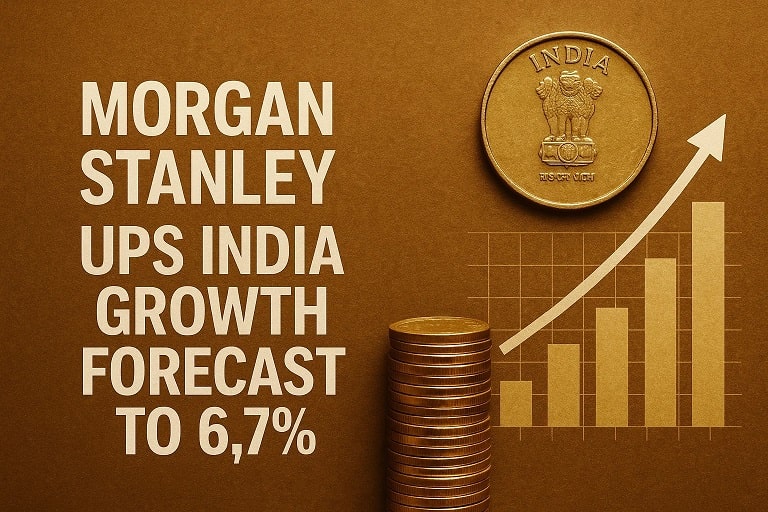Morgan Stanley Ups India’s Growth Forecast to 6.7%: Insights into Economic Momentum and Future Prospects
In a significant boost to India’s economic narrative, global financial powerhouse Morgan Stanley has revised its growth forecast for the country’s fiscal year 2025-26 upwards to 6.7 percent. This upgrade comes amid robust quarterly performance and optimistic indicators that signal resilience in one of the world’s fastest-growing major economies. This move underscores India’s ability to navigate global headwinds while capitalizing on domestic strengths, positioning it as a beacon of stability in an uncertain global landscape.
Why This Forecast Matters
Morgan Stanley’s adjustment from a previous estimate of 6.2 percent highlights confidence in India’s structural reforms and demand-driven recovery. With global uncertainties like US tariff hikes looming, this revision emphasizes how internal factors such as consumption and agriculture could shield the economy. For CEOs and executives, this signals opportunities in sectors poised for expansion, while investors may see it as a cue to ramp up allocations to Indian assets.
Latest Economic Events Leading to the Upgrade
The catalyst for Morgan Stanley’s optimistic revision is India’s impressive 7.8 percent year-on-year GDP growth in the April-June quarter of 2025, surpassing the 7.4 percent recorded in the previous quarter. This strong start to FY26 reflects buoyant domestic demand, front-loaded government spending, and moderating inflation that has enhanced real wages and consumer spending.
Surge in GST Collections
Adding to the positive momentum, India’s Goods and Services Tax (GST) collections for August 2025 rose 6.5 percent year-on-year to ₹1.86 lakh crore, marking the eighth straight month above ₹1.8 lakh crore. Gross domestic revenue climbed 9.6 percent to ₹1.37 lakh crore, while net GST revenue grew 10.7 percent to ₹1.67 lakh crore. This uptick indicates heightened economic activity, with refunds dropping 20 percent, allowing more funds to circulate within the system.
Agricultural Resilience and Monsoon Boost
A favorable monsoon season and robust kharif sowing have fortified the agricultural sector, promising sustained rural demand. These elements, combined with the upcoming festive season, are expected to further propel consumption, countering potential drags from external factors.
Historical Context of Morgan Stanley’s Forecasts for India
Morgan Stanley’s forecasts for India’s GDP have evolved amid fluctuating global and domestic conditions. In November 2024, the firm lowered its FY25 estimate to 6.7 percent from 7 percent, citing a slowdown in the September quarter. By May 2025, it upgraded FY26 projections to 6.2 percent from 6.1 percent and FY27 to 6.5 percent, driven by easing US-China trade tensions and rising capital expenditure.
Key Revisions Timeline
- November 2024: FY25 forecast trimmed to 6.7 percent due to weaker Q2 data and external pressures.
- May 2025: Upward revision for FY26 to 6.2 percent, reflecting improved domestic demand and policy stability.
- July 2025: India positioned as the fastest-growing economy with 5.9 percent growth projected for 2025.
- September 2025: Latest hike to 6.7 percent for FY26, emphasizing domestic resilience.
This pattern shows Morgan Stanley’s responsiveness to data, with upgrades often tied to strong quarterly performances and downgrades linked to global risks.
Future Scopes and Projections
Looking ahead, Morgan Stanley anticipates a rebalancing of growth drivers, with private sector demand taking the lead as public spending softens and goods exports weaken. Expected GST rate cuts could add up to 50 basis points to growth, stimulating demand and offsetting a similar drag from US tariffs.
Long-Term Outlook
By FY27, growth could stabilize around 6.5 percent, supported by structural reforms, digitalization, and infrastructure investments. India is projected to contribute one-fifth of global growth in the coming decade, with GDP per capita rising significantly. However, risks like geopolitical tensions and global slowdowns remain, potentially impacting exports.
Potential Challenges
Net exports have already turned negative due to faster import growth, a trend that may persist if external demand falters. Monetary policy easing is not expected until April 2026, maintaining a focus on inflation control.
Impacts on the Indian Economy and Investors
This forecast upgrade is poised to enhance investor confidence, potentially driving inflows into equities and bonds. For the economy, it signals accelerated job creation, higher corporate earnings, and improved fiscal health.
Sector-Wise Impacts
Manufacturing and Exports
While domestic demand surges, export-oriented sectors may face headwinds from tariffs, but overall growth could mitigate this through diversified markets.
Agriculture and Rural Economy
Strong monsoons and rural resilience will bolster consumption, benefiting FMCG and agri-input companies.
Financial Markets
Stock markets could see bullish trends, with Morgan Stanley eyeing Sensex at 100,000 by June 2026, driven by low volatility and falling rates.
Investment Opportunities
Foreign investors may increase exposure, viewing India as a safe haven amid global uncertainties.
Comparison of GDP Forecasts
| Fiscal Year | Previous Forecast (%) | Revised Forecast (%) | Key Driver for Change |
|---|---|---|---|
| FY25 | 7.0 | 6.7 | Q2 slowdown |
| FY26 | 6.2 | 6.7 | Robust Q1 growth |
| FY27 | 6.3 | 6.5 | Domestic demand |
This table illustrates the progressive optimism in Morgan Stanley’s projections.
Frequently Asked Questions (FAQs)
What prompted Morgan Stanley to raise India’s FY26 growth forecast to 6.7%?
The upgrade stems from strong 7.8% growth in Q1 FY26, expected GST cuts, festive demand, and rural strength offsetting external drags.
How does this compare to previous revisions?
Earlier in 2025, FY26 was pegged at 6.2%, up from 6.1% in May, reflecting ongoing positive adjustments.
What are the risks to this forecast?
Global tariffs, geopolitical issues, and slower exports pose challenges, though domestic factors provide a buffer.
How will this impact investors?
It could lead to higher stock valuations and increased foreign investments, emphasizing India’s growth story.
Is India still the fastest-growing major economy?
Yes, with projections maintaining its lead through 2026.













